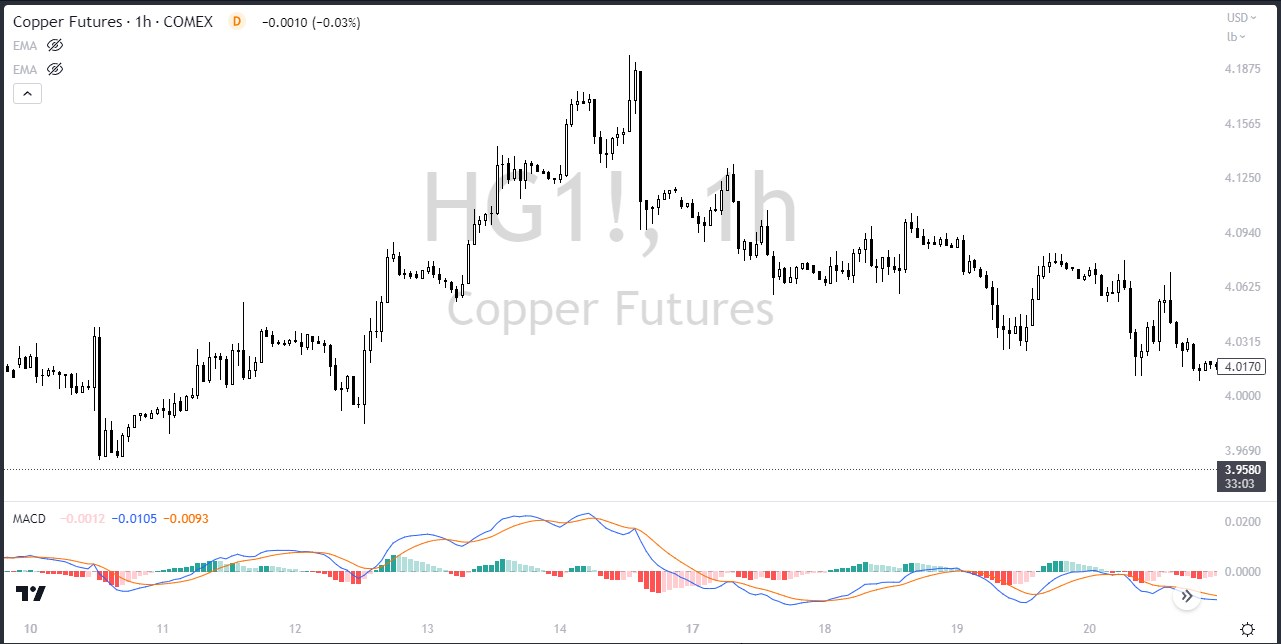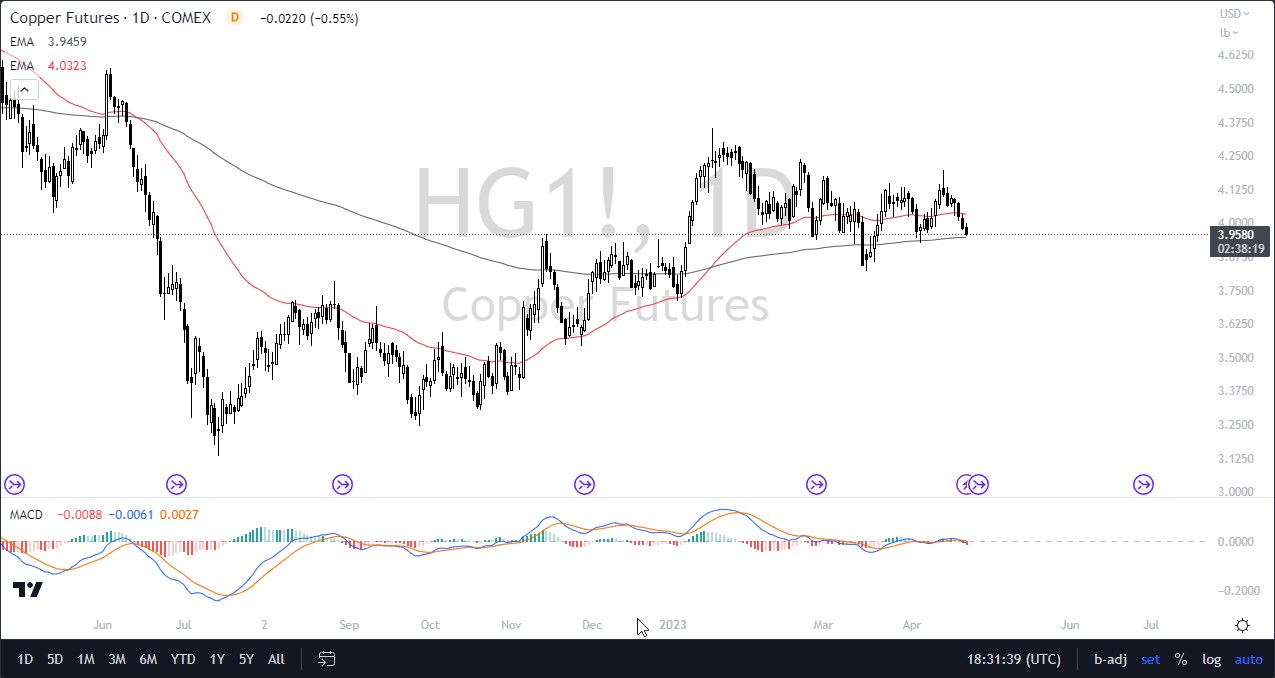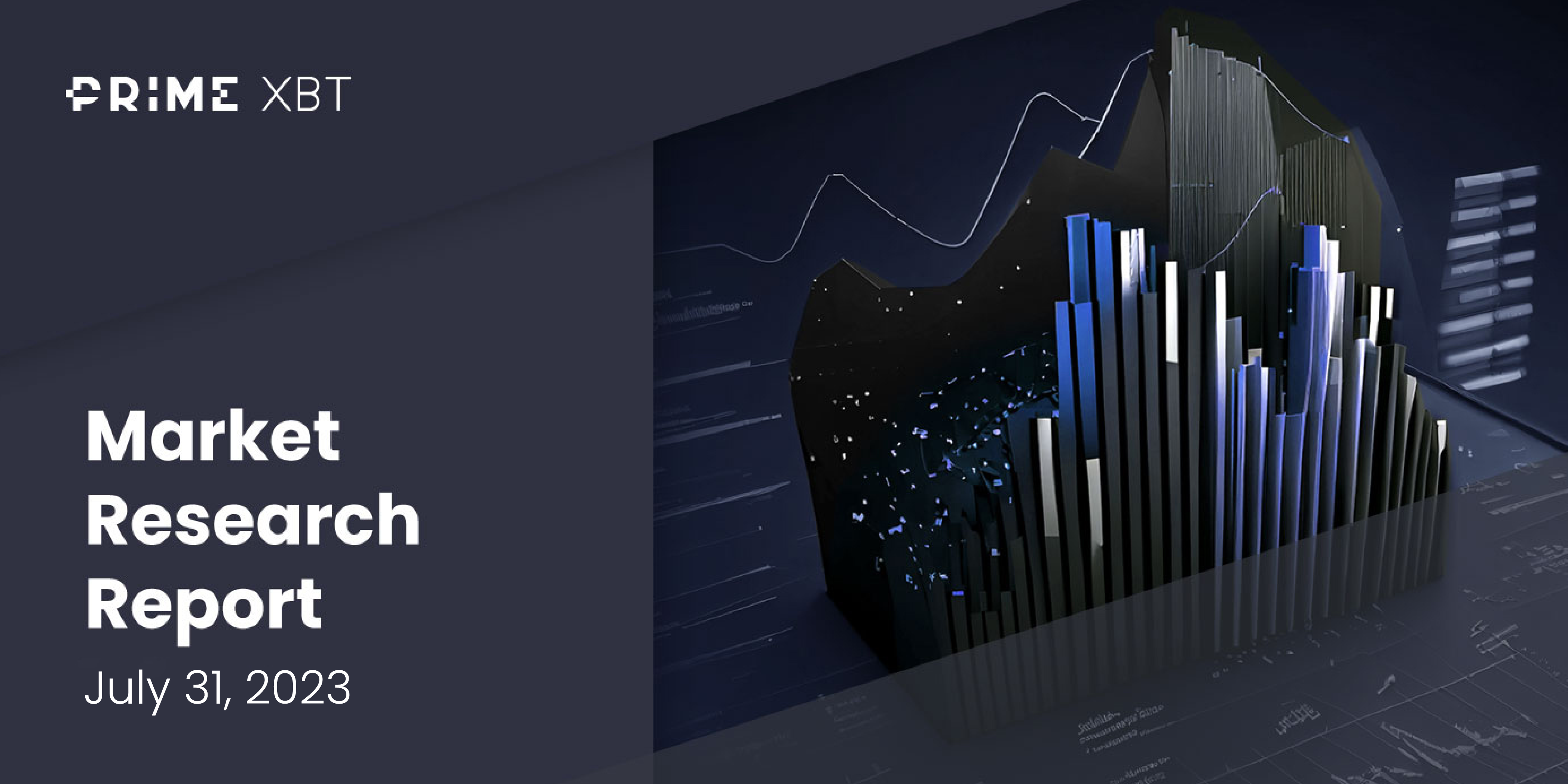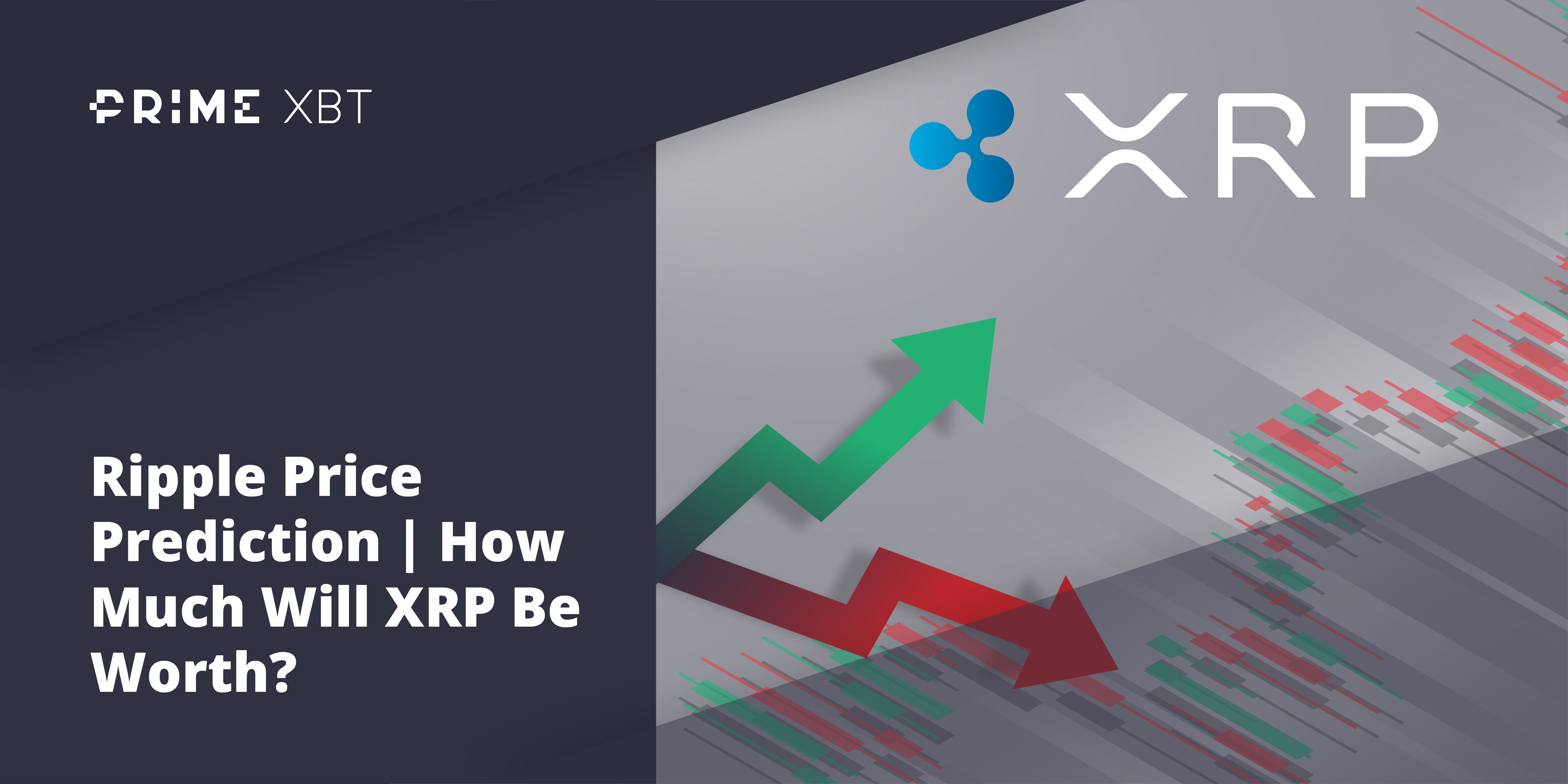Buying and selling copper as a commodity on international platforms like the London Metal Exchange (LME) or the New York Mercantile Exchange (NYMEX) is referred to as copper trading. One of the most frequently used metals in the world, copper has a wide range of uses, from electrical lines to building supplies. Trading in copper is a significant part of the world’s commodities markets as a result. Copper isn’t the same thing as a precious metal, so it has it’s own behavior.
Trading in copper is significant because it serves as a leading indicator of economic activity, especially in the manufacturing and construction industries. Copper price movements are frequently viewed as an early indicator of changes in inflation and economic growth. Additionally, copper is a crucial ingredient for numerous sectors, therefore disruptions to copper supply can have ripple effects across the global economy. It has an extreme positive correlation to the housing market as well, due to electrical wiring, plumbing, and many other parts.
In this article, we will look at the various factors that go into the trading copper contracts, and other copper-related markets. Understanding the importance of copper can help you with a bias on risk appetite in the overall markets.
Why Trade Copper? Copper Demand Keeps Growing
There are various reasons for trading copper:
Copper trading can help a portfolio’s diversity. Because it has a low connection with other asset classes like equities and bonds, copper can help to lower portfolio volatility while also possibly increasing returns because it is a commodity.
Copper is frequently regarded as an inflation hedge because its price tends to grow along with inflation. This means that investors can hedge their portfolios against the consequences of inflation by trading copper.
Copper is a significant economic indicator, notably in the manufacturing and construction industries. Copper price variations can offer information about changes in inflation and economic growth, which can assist traders make wise investment selections.
Global macroeconomic conditions, supply and demand considerations, and the price of copper all affect its price. This indicates that trading futures, options, CFDs, or ETFs may present possibilities for traders to profit from market volatility.
One recent example of the copper markets being a great place to trade: Due to supply shortages and higher demand brought on by China’s infrastructure projects, copper prices surged between 2016 and 2017. As a result, copper prices increased by about 50% during this time, providing traders and investors who purchased copper futures or held copper-related equities with huge returns.
Copper Trading Basics
In order to profit from the copper markets, there are some basic things you will need to know.
What is the trading symbol for copper?
The symbols for copper futures trading depend on the exchange where the commodity is being traded. Here is a list for the copper futures symbol on some of the major exchanges:
New York Mercantile Exchange (NYMEX): On NYMEX, copper futures are traded under the symbol HG.
London Metal Exchange (LME): On LME, copper futures are traded under the symbol CU.
Shanghai Futures Exchange (SHFE): On SHFE, copper futures are traded under the symbol SC.
If you are looking into the ETF market, there are quite a few ways to invest, and the symbols can be broken down by mining, total return indices, and more. However, the most traded copper ETF is CPER on the New York Stock Exchange.
What are the different ways to trade copper?
Copper trading hours
If you are looking to buy copper, sell copper, and gain full market exposure, these are the times of the largest metal exchanges.
On the CME Globex exchange, copper can be traded from Sunday to Friday between 6:00 p.m. and 5:00 p.m. (5:00 p.m. – 4:00 p.m. CT), with a 60-minute break each day beginning at 5:00 p.m. (4:00 p.m. CT).
Copper can also be traded on the London Metal Exchange from Monday to Friday between 1:00 a.m. and 7:00 p.m. Greenwich Mean Time, and on the New York Mercantile Exchange from Sunday to Friday between 6:00 p.m. and 5:00 p.m. U.S ET.
Copper can be traded through various instruments such as bullion, contracts for difference (CFDs), futures, options, ETFs, and shares. Copper is also actively traded in the over-the-counter market through forward contracts that are privately negotiated and can look like futures contracts.
It is most heavily traded during the US and UK sessions, although many countries around the world have copper-related ETFs and companies listed on their exchanges. That being said, you need to be aware that there are differences in the copper futures market and the other assets.
Copper futures are highly levered and can be dangerous if you do not have the proper account size. A futures contract will sometimes be a bit expensive, but if you trade copper CFDs, you can cut the size of the trade down to suit your risk tolerance easily. The stock market is also a great way to take advantage of the copper price, and can easily be bought and sold in a liquid environment.
What are useful indicators for copper trading?
A variety of trading indicators are used by traders to help them make decisions. A copper trading strategy will often use indicators. Several of the well-liked trading indicators are listed below:
Moving averages: This indicator shows the average price of the item over a certain period of time. Traders use moving averages to spot trends and potential levels of support and resistance.
Relative Strength Index (RSI): By comparing gains and losses over a specific time period, this oscillator evaluates the strength of a security’s price action. It assists traders in determining when an asset is overbought or oversold.
Stochastic Oscillator: This indicator assesses the relationship between an asset’s closing price and its price range over a preset period of time. It helps traders identify potential trend reversals.
Bollinger Bands: The Bollinger Bands indicator consists of a moving average with upper and lower bands depending on standard deviations. Traders use Bollinger Bands to spot potential breakouts and reversals.
Fibonacci Retracement: This indicator uses horizontal lines and the Fibonacci sequence to pinpoint possible areas of support and resistance. Individuals and businesses use this indication to identify prospective entry and exit points.
There are certain typical strategies that many traders employ, while each trader will have their own method for deciding when and how to purchase or sell. This can entail employing a moving average at the same price in addition to a Fibonacci retracement level. Technical analysis often has a big impact on commodity prices, so this makes a lot of sense.
Using the MACD indicator, they can also choose to trade; as the moving averages cross the “zero line,” they can choose to buy or sell depending on which way it breaks.

What moves the price of copper?
The dynamics of global supply and demand, macroeconomic conditions, geopolitical events, and currency movements all have an impact on copper prices. Global copper demand (Also known as “Dr Copper” due to its ability to show global growth or weakness.) is determined by various factors, and here are some further specifics for each of the most common ones:
Supply and demand: Global supply and demand dynamics have a significant impact on copper pricing. The price of copper can be impacted by any changes in supply or demand. For instance, the price of copper will rise if demand rises while supply remains the same. On the other hand, if supply rises and demand stays the same, copper prices will fall.
Macroeconomic Situation: Copper pricing is significantly influenced by the state of the global economy. Several industries, including manufacturing, transportation, and construction, require copper. As a result, any changes in the economy that have an impact on these sectors, such as those in interest rates, inflation, or trade policy, may have an impact on the price of copper.
Geopolitical Events: In addition to political unrest and labor problems, copper prices can be significantly impacted by natural disasters. For instance, supply disruptions caused by natural disasters, political unrest, or mining strikes can increase copper prices.
Currency Fluctuations: Since copper is valued in US dollars, any changes in exchange rates may have an effect on copper prices. If the US dollar gains strength, foreign importers of copper may find it more expensive, which would reduce demand and prices.
How to Start Trading Copper
Before you start trading the copper markets, there are some things that you need to know about the process of getting up and running. There is more than simply just betting on copper pricing. You need to have access to the financial markets to take advantage of the demand, or lack of demand for copper. This process will be basically the same no matter if you are looking to trade copper CFDs, trading commodity futures, or even precious metal markets.
Open a live trading account
If you’re looking for a trustworthy broker that provides the services you require, you’ll need to do some research to find the right one for you. Some important factors to consider include costs, trading platforms, customer service, and security. Once you’ve decided on a broker, you’ll need to fill out an account application, which typically requires personal information such as your name, address, birth date, and government-issued identification number. Additionally, you may be asked about your career and finances, including your salary and net worth.
To comply with anti-money laundering legislation, brokers must confirm the identity of their clients. This may involve providing a copy of your government-issued ID or passport, as well as additional paperwork like a utility bill or bank statement.
Once your account has been approved and funded, and your identity has been confirmed, you can start trading using the trading platform provided by your broker. Your broker will also give you access to other resources to help you manage your money.
Make a deposit
Depending on the broker or trading platform you choose, you may need to fund an account. However, most brokers offer a variety of funding sources, including:
- Bank Transfer: You can transfer money to your account using a bank transfer.
- Credit/Debit Card: You can fund your trading account using a credit or debit card.
- Electronic Payment Methods: You can fund your account using electronic payment methods like PayPal, Skrill, Neteller, or others.
- Cryptocurrencies: Bitcoin, Ethereum, and Litecoin are just a few examples of cryptocurrencies that certain brokers accept as payment. Top Coin Miners is one that does.
Create a risk management strategy
It is impossible to exaggerate the value of risk management. Simply said, safeguarding your account should be your top priority if you want to generate money. A position must have an end point where you leave it.
In order for the trader’s account to return to break even after a 10% loss, there must be an 11% gain. A return of 25% is required to make up for a loss of 20% for the trader. However, it just requires a 1.01% gain if the trader loses 1% of a trade. This demonstrates how crucial it is to minimize losses.
Monitor your trades
Due to the markets’ potential volatility, it is crucial to keep an eye on your trades. You must monitor your trades because significant news from nations like China might prompt swift movements. Start by adjusting stop-loss orders to breakeven when the market advances in your favor.
Keep an eye out for the next obstacles that will be in your path. As your business overcomes these obstacles, be sure to, if at all feasible, safeguard your profits. Making sure you don’t let losses get out of control is equally crucial. The last thing you want to do is to ignore the market, and start losing money rapidly.
Copper Trading Strategies
If you are planning to trade copper, you will need to develop a trading strategy before risking any money in the markets. Copper is different than precious metals, as they focus on financial conditions. Unlike precious metals, copper is a pure play on growth, or the lack of.
There are numerous techniques to make money with copper, as well as numerous approaches to the markets. The trader can employ news releases, fundamental analysis, technical analysis, and even fundamental analysis to place positions. There is no “one size fits all” strategy, but there are some fundamental building blocks to take into account:
Technical analysis: Financial professionals use technical analysis as a technique to assess and forecast price changes by examining past market data including price and volume. This study entails visually evaluating and forecasting pricing movements based on historical patterns and statistics in order to identify potential trading opportunities and benefits. Technical analysts regularly estimate the fair market value of assets in accordance with their conviction that the sum of all actions taken by market participants
Fundamental analysis: A process called fundamental analysis is used to assess a security’s underlying value by looking at its financial and economic components. To establish intrinsic value, which should be reflected in future price, it entails analyzing the financial statements, market trends, and macroeconomic factors. One sector that seems to have an outsized effect on the market is the housing market, as electrical wiring is a large consumer of the metal.
Fundamental analysis’ main objective is to spot undervalued or overvalued securities or assets so that investors can make judgments about their investments based on the market’s long-term prospects. Fundamental analysts hold that markets may at any given time undervalue or overvalue an asset, and it is the analyst’s job to spot these possibilities.

In the chart above, the 50-Day EMA rose above the 200-Day EMA several weeks ago, suggesting that copper futures contracts were going to rally. Since then, consolodation has shown itself in the market.
The Bottom Line
Learning how to trade the copper market is learning how to trade copper CFDs, copper futures, copper ETFs, etc in order to take advantage of the overall outlook for the global economic health. The market exposure of copper is going to be a way to place a bet on strength or weakness, if you are shorting it.
Another thing that you will have to pay close attention to is emerging markets and the demand coming from them, especially China. Emerging markets tend to be where the largest amount of demand for copper comes from, and therefore it automatically makes copper a leading indicator. It also worth noting that Chile is the largest copper producer in the world, adding more importance on the emerging markets.
Industrial manufacturing and transportation equipment can have a major influence on comex copper prices, which has a “knock-on effect” in other markets. While there are some substitute metals that people will try to use, copper remains a major raw material when looking at infrastructure growth.
You can trade CFDs, futures contracts, which allows you to bet on the price of copper at a future date, stocks, and build trading strategies that allow you to determine buy and sell signals. A futures contract is the most common way to benefit from price movement, but this will come down to the size of your account. Remember, there are exchange traded funds that you can get involved with as well if you are more comfortable with a lack of leverage, but still want to gain exposure to the market, or even the copper stocks can play a part.
Global economic growth is something that you need to understand if you are trading any market, so even if you don’t decide to get invovled, monitoring the copper market will be a great way to gague overall risk appetite. Copper brokers will offer various ways to get involved, or at least monitor the demand. You also can forgo all of this, by owning physical copper, but the metal demands a large storage space, making it somewhat impractical for retail investor accounts.
Is copper good for trading?
Yes, copper futures contracts and other forms of copper assets are great for trading. The commodity markets in copper can give a bit of a "heads up" about the economy, and whether we are in expansion, or contraction.
Copper bullion bars are also a way to take advantage of the demand for copper, however, its does bring in the idea of storage costs to hold the assets. Physical copper bullion is typically used by larger hedge funds, not retail investor accounts. Most will either be trading copper futures contracts, ETFs, copper mining stocks, or other "paper assets."
Can i trade copper online?
Yes, you can. Learning how to trade copper is the same as any other asset. Education is key. You can trade copper futures, copper ETF markets, using a copper CFD market, and company stocks that are highly levered to the copper markets and demand.
What is the highest price of copper in history?
Copper traded its highest recorded price of US$5.02 per pound or more than $10,600 per metric tonne on the LME in March 2022, marking the highest price ever recorded for the metal. Fears of supply chain disruptions, record low stockpiles, and increased demand for copper all contributed to this price increase. Prior to this, the spot price of copper reached $10,000 per metric tonne in February 2011, marking the highest price ever seen for the metal.
When should I trade copper?
You should trade depending on your financial goals, and your timeframe. After all, there are a lot of companies that you can buy and hold as stocks that move with copper. However, if you are looking for short-term moves, then you may want to move toward trading in the UK or US sessions, as the main metals exchanges are based in New York and London.


